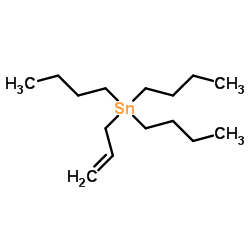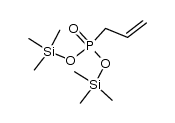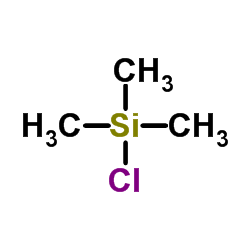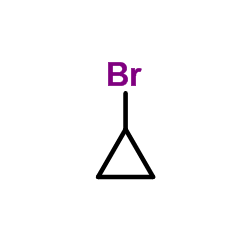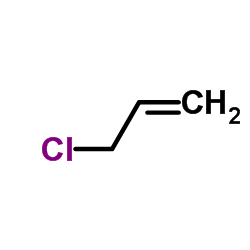1498-47-1
| 中文名 | 二氯化烯丙基膦 |
|---|---|
| 英文名 | 3-dichlorophosphorylprop-1-ene |
| 英文别名 |
3-dichloro-phosphoryl-prop-1-ene
allyl-phosphonic acid-dichloride MFCD00010385 (2-Propenyl)-phosphinic dichloride Allyl-phosphonsaeure-dichlorid allylphosphonyl dichloride Allylphosphonic dichloride |
| 密度 | 1.33 |
|---|---|
| 沸点 | 75-77ºC(16mmHg) |
| 分子式 | C3H5Cl2OP |
| 分子量 | 158.95100 |
| 闪点 | 68.5ºC |
| 精确质量 | 157.94600 |
| PSA | 26.88000 |
| LogP | 2.84310 |
| 蒸汽压 | 0.781mmHg at 25°C |
| 折射率 | 1.486-1.488 |
| 储存条件 | 密封储存,储存于阴凉、干燥的库房。远离腐蚀区。常用氮气保护。 |
| 稳定性 | 常温常压下稳定,避免与不相容材料,潮湿空气,水接触。
与强氧化剂,强碱反应。 |
| 计算化学 | 1.疏水参数计算参考值(XlogP):1.6 2.氢键供体数量:0 3.氢键受体数量:1 4.可旋转化学键数量:2 5.互变异构体数量:无 6.拓扑分子极性表面积17.1 7.重原子数量:7 8.表面电荷:0 9.复杂度:106 10.同位素原子数量:0 11.确定原子立构中心数量:0 12.不确定原子立构中心数量:0 13.确定化学键立构中心数量:0 14.不确定化学键立构中心数量:0 15.共价键单元数量:1 |
| 更多 | 1. 性状:无色透明液体 2. 密度(g/mL,25℃):1.33 3. 相对蒸汽密度(g/mL,空气=1):未确定 4. 熔点(ºC):未确定 5. 沸点(ºC,常压):未确定 6. 沸点(ºC,16mmHg):75-77 7. 折射率(n20/D):1.486-1.488 8. 闪点(ºC):未确定 9. 比旋光度(º):未确定 10. 自燃点或引燃温度(ºC):未确定 11. 蒸气压(mmHg,20ºC):未确定 12. 饱和蒸气压(kPa,25ºC):未确定 13. 燃烧热(KJ/mol):未确定 14. 临界温度(ºC):未确定 15. 临界压力(KPa):未确定 16. 油水(辛醇/水)分配系数的对数值:未确定 17. 爆炸上限(%,V/V):未确定 18. 爆炸下限(%,V/V):未确定 19. 溶解性:未确定 |
Synonym:None Known Section 2 - COMPOSITION, INFORMATION ON INGREDIENTS
Risk Phrases: 34 Section 3 - HAZARDS IDENTIFICATION EMERGENCY OVERVIEW
Causes burns.Moisture sensitive.Corrosive. Potential Health Effects Eye: Causes eye burns. May cause chemical conjunctivitis and corneal damage. Skin: Causes skin burns. May cause skin rash (in milder cases), and cold and clammy skin with cyanosis or pale color. Ingestion: May cause severe and permanent damage to the digestive tract. Causes gastrointestinal tract burns. May cause perforation of the digestive tract. May cause cardiac disturbances. The toxicological properties of this substance have not been fully investigated. May cause central nervous system effects. May cause systemic effects. Inhalation: May cause irritation of the respiratory tract with burning pain in the nose and throat, coughing, wheezing, shortness of breath and pulmonary edema. Causes chemical burns to the respiratory tract. Aspiration may lead to pulmonary edema. May cause cardiac abnormalities. May cause systemic effects. May cause Central Nervous System Effects characterized by apathy, mental confusion, blurred vision, and tremors. Chronic: Effects may be delayed. Section 4 - FIRST AID MEASURES Eyes: Get medical aid immediately. Do NOT allow victim to rub eyes or keep eyes closed. Extensive irrigation with water is required (at least 30 minutes). Skin: Get medical aid immediately. Immediately flush skin with plenty of water for at least 15 minutes while removing contaminated clothing and shoes. Destroy contaminated shoes. Ingestion: Do not induce vomiting. If victim is conscious and alert, give 2-4 cupfuls of milk or water. Never give anything by mouth to an unconscious person. Get medical aid immediately. Inhalation: Get medical aid immediately. Remove from exposure and move to fresh air immediately. If breathing is difficult, give oxygen. Do NOT use mouth-to-mouth resuscitation. If breathing has ceased apply artificial respiration using oxygen and a suitable mechanical device such as a bag and a mask. Notes to Physician: Section 5 - FIRE FIGHTING MEASURES General Information: As in any fire, wear a self-contained breathing apparatus in pressure-demand, MSHA/NIOSH (approved or equivalent), and full protective gear. During a fire, irritating and highly toxic gases may be generated by thermal decomposition or combustion. Will burn if involved in a fire. Containers may explode in the heat of a fire. Contact with metals may evolve flammable hydrogen gas. Runoff from fire control or dilution water may cause pollution. Extinguishing Media: Do NOT get water inside containers. For small fires, use dry chemical, carbon dioxide, or water spray. For large fires, use dry chemical, carbon dioxide, alcohol-resistant foam, or water spray. Cool containers with flooding quantities of water until well after fire is out. Section 6 - ACCIDENTAL RELEASE MEASURES General Information: Use proper personal protective equipment as indicated in Section 8. Spills/Leaks: Absorb spill with inert material (e.g. vermiculite, sand or earth), then place in suitable container. Clean up spills immediately, observing precautions in the Protective Equipment section. Provide ventilation. Do not get water inside containers. Section 7 - HANDLING and STORAGE Handling: Use only in a well-ventilated area. Do not breathe dust, vapor, mist, or gas. Do not get in eyes, on skin, or on clothing. Keep container tightly closed. Do not ingest or inhale. Do not allow contact with water. Discard contaminated shoes. Keep from contact with moist air and steam. Storage: Keep container closed when not in use. Store in a tightly closed container. Keep under a nitrogen blanket. Corrosives area. Store protected from moisture. Section 8 - EXPOSURE CONTROLS, PERSONAL PROTECTION Engineering Controls: Facilities storing or utilizing this material should be equipped with an eyewash facility and a safety shower. Use adequate ventilation to keep airborne concentrations low. Exposure Limits CAS# 1498-47-1: Personal Protective Equipment Eyes: Wear appropriate protective eyeglasses or chemical safety goggles as described by OSHA's eye and face protection regulations in 29 CFR 1910.133 or European Standard EN166. Skin: Wear appropriate protective gloves to prevent skin exposure. Clothing: Wear appropriate protective clothing to prevent skin exposure. Respirators: Follow the OSHA respirator regulations found in 29 CFR 1910.134 or European Standard EN 149. Use a NIOSH/MSHA or European Standard EN 149 approved respirator if exposure limits are exceeded or if irritation or other symptoms are experienced. Section 9 - PHYSICAL AND CHEMICAL PROPERTIES Physical State: Clear liquid Color: colorless Odor: Not available. pH: Not available. Vapor Pressure: Not available. Viscosity: Not available. Boiling Point: 75 - 77 deg C @ 16.00mmHg Freezing/Melting Point: Not available. Autoignition Temperature: Not available. Flash Point: > 110 deg C (> 230.00 deg F) Explosion Limits, lower: Not available. Explosion Limits, upper: Not available. Decomposition Temperature: Solubility in water: Specific Gravity/Density: 1.3340g/cm3 Molecular Formula: H2C=CHCH2P(O)Cl2 Molecular Weight: 158.95 Section 10 - STABILITY AND REACTIVITY Chemical Stability: Stable under normal temperatures and pressures. Conditions to Avoid: Incompatible materials, moisture, exposure to moist air or water. Incompatibilities with Other Materials: Moisture, oxidizing agents. Hazardous Decomposition Products: Hydrogen chloride, carbon monoxide, carbon dioxide, thermal decomposition may produce toxic fumes of phosphorous oxides and/or phosphine. Hazardous Polymerization: Has not been reported Section 11 - TOXICOLOGICAL INFORMATION RTECS#: CAS# 1498-47-1 unlisted. LD50/LC50: Not available. Carcinogenicity: Allylphosphonic Dichloride - Not listed by ACGIH, IARC, or NTP. Section 12 - ECOLOGICAL INFORMATION Ecotoxicity: Fish: Pseudomonas putida: Section 13 - DISPOSAL CONSIDERATIONS Dispose of in a manner consistent with federal, state, and local regulations. Section 14 - TRANSPORT INFORMATION IATA Shipping Name: Not regulated. Hazard Class: UN Number: Packing Group: IMO Shipping Name: Not regulated. Hazard Class: UN Number: Packing Group: RID/ADR Shipping Name: Not regulated. Hazard Class: UN Number: Packing group: Section 15 - REGULATORY INFORMATION European/International Regulations European Labeling in Accordance with EC Directives Hazard Symbols: C Risk Phrases: R 34 Causes burns. Safety Phrases: S 25 Avoid contact with eyes. S 36/37/39 Wear suitable protective clothing, gloves and eye/face protection. S 45 In case of accident or if you feel unwell, seek medical advice immediately (show the label where possible). WGK (Water Danger/Protection) CAS# 1498-47-1: No information available. Canada None of the chemicals in this product are listed on the DSL/NDSL list. CAS# 1498-47-1 is not listed on Canada's Ingredient Disclosure List. US FEDERAL TSCA CAS# 1498-47-1 is not listed on the TSCA inventory. It is for research and development use only. SECTION 16 - ADDITIONAL INFORMATION N/A |
|
~92% 
1498-47-1 |
| 文献:Rogers, Roland S. Tetrahedron Letters, 1992 , vol. 33, # 49 p. 7473 - 7474 |
|
~85% 
1498-47-1 |
| 文献:Rouand, Herve; Potin, Philippe; Majoral, Jean-Pierre; Bertrand, Guy Tetrahedron Letters, 1992 , vol. 33, # 52 p. 8095 - 8098 |
|
~93% 
1498-47-1 |
| 文献:Morita, Tsuyoshi; Okamoto, Yoshiki; Sakurai, Hiroshi Chemistry Letters, 1980 , p. 435 - 438 |
|
~80% 
1498-47-1 |
| 文献:Bhongle, Nandkumar N.; Notter, Robert H.; Turcotte, Joseph G. Synthetic Communications, 1987 , vol. 17, # 9 p. 1071 - 1076 |
|
~83% 
1498-47-1 |
| 文献:Zafrani, Yossi; Chen, Ravit; Ashkenazi, Nissan; Segall, Yoffi Synthetic Communications, 2008 , vol. 38, # 6 p. 848 - 857 |
|
~% 
1498-47-1 |
| 文献:Kinnear; Perren Journal of the Chemical Society, 1952 , p. 3437,3440 |
| 海关编码 | 2931900090 |
|---|---|
| 中文概述 | 2931900090. 其他有机-无机化合物. 增值税率:17.0%. 退税率:13.0%. 监管条件:AB(入境货物通关单,出境货物通关单). 最惠国关税:6.5%. 普通关税:30.0% |
| Summary | 2931900090. other organo-inorganic compounds. VAT:17.0%. Tax rebate rate:13.0%. Supervision conditions:AB(certificate of inspection for goods inward,certificate of inspection for goods outward). MFN tariff:6.5%. General tariff:30.0% |


